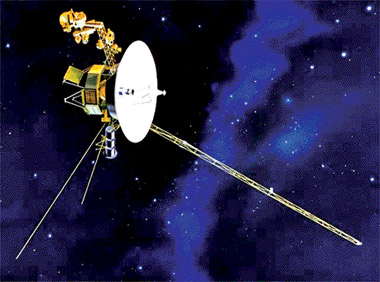|
Recalculating the distance to
interstellar space
Scientists analysing recent data from NASA's Voyager and Cassini
spacecraft have calculated that Voyager 1 could cross over into the
frontier of interstellar space at any time and much earlier than
previously thought.The findings are detailed in this week's issue of the
journal Nature. Data from Voyager's low-energy charged particle
instrument, first reported in December 2010, have indicated that the
outward speed of the charged particles streaming from the sun has slowed
to zero.
 The stagnation of this solar wind has continued through at least
February 2011, marking a thick, previously unpredicted "transition zone"
at the edge of our solar system."There is one time we are going to cross
that frontier, and this is the first sign it is upon us," said Tom
Krimigis, prinicipal investigator for Voyager's low-energy charged
particle instrument and Cassini's magnetospheric imaging instrument,
based at the Johns Hopkins University Applied Physics Laboratory in
Laurel, Md.Krimigis and colleagues combined the new Voyager data with
previously unpublished measurements from the ion and neutral camera on
Cassini's magnetospheric imaging instrument. The stagnation of this solar wind has continued through at least
February 2011, marking a thick, previously unpredicted "transition zone"
at the edge of our solar system."There is one time we are going to cross
that frontier, and this is the first sign it is upon us," said Tom
Krimigis, prinicipal investigator for Voyager's low-energy charged
particle instrument and Cassini's magnetospheric imaging instrument,
based at the Johns Hopkins University Applied Physics Laboratory in
Laurel, Md.Krimigis and colleagues combined the new Voyager data with
previously unpublished measurements from the ion and neutral camera on
Cassini's magnetospheric imaging instrument.
The Cassini instrument collects data on neutral atoms streaming into
our solar system from the outside.The analysis indicates that the
boundary between interstellar space and the bubble of charged particles
the sun blows around itself is likely between 10 and 14 billion miles
(16 to 23 kilometres) from the sun, with a best estimate of
approximately 11 billion miles (18 billion kilometres). Since Voyager 1
is already nearly 11 billion miles (18 billion kilometres) out, it could
cross into interstellar space at any time.
"These calculations show we're getting close, but how close? That's
what we don't know, but Voyager 1 speeds outward a billion miles every
three years, so we may not have long to wait," said Ed Stone, Voyager
project scientist, based at the California Institute of Technology in
Pasadena.Scientists intend to keep analysing the Voyager 1 data, looking
for confirmation. They will also be studying the Voyager 2 data, but
Voyager 2 is not as close to the edge of the solar system as Voyager 1.
Voyager 2 is about 9 billion miles (14 billion kilometers) away from the
sun.Launched in 1977, the Voyager twin spacecraft have been on a 33-year
journey.
They are humanity's farthest working deep space sentinels enroute to
reach the edge of interstellar space. The Voyagers were built by NASA's
Jet Propulsion Laboratory in Pasadena, Calif., which continues to
operate both spacecraft.
The Voyager missions are a part of the NASA Heliophysics System
Observatory, sponsored by the Heliophysics Division of NASA's Science
Mission Directorate in Washington. JPL is managed for NASA by Caltech.
- Science Daily |

